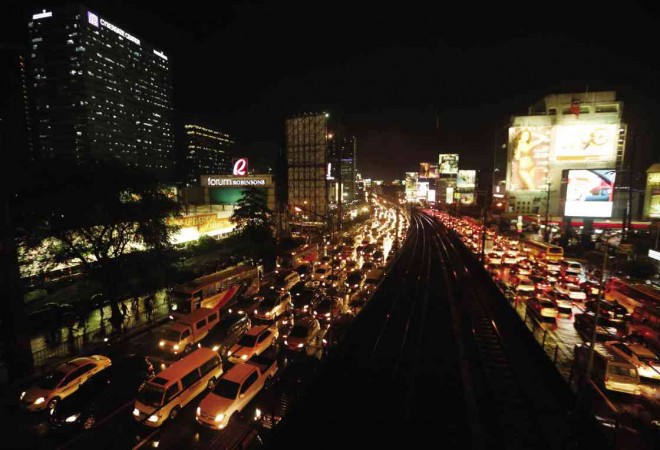DPWH chief: Subway rail master plan done this year

EDSA NIGHTMARE PART II Still at a standstill, traffic on Edsa near Pioneer St. in Mandaluyong on Thursday night after the sudden heavy downpour looks and feels irritatingly familiar. Malacañang has affirmed Public Works Secretary Rogelio Singson’s assertion that adding more trains to the existing Metro Manila mass transit systems would greatly ease traffic. LYN RILLON
Malacañang has affirmed Public Works Secretary Rogelio Singson’s assertion that adding more trains to the existing Metro Manila mass transit systems would greatly ease traffic.
In June, the Department of Public Works and Highways (DPWH) said it expected to complete the master plan for a subway mass transit system in the metropolis within the year.
The underground rail system forms part of the government’s road map for transport infrastructure development prepared by the Japan International Cooperation Agency (Jica).
The road map, also called the “Dream Plan 2030,” calls for the construction of an integrated mass transport system in Metro Manila and the neighboring provinces of Rizal, Cavite, Bulacan and Laguna.
“In the absence of more trains, we use buses,” Singson said in a text message on Thursday, explaining his program to dedicate two lanes to buses on Edsa.
Article continues after this advertisementCommunications Secretary Herminio Coloma Jr. on Thursday told the Inquirer: “Yes, we affirm that more mass transit facilities are needed.”
Article continues after this advertisementAsked if the Palace was confident the traffic situation would improve, he said they were “doing our best to improve the situation.”
“It’s a continuing process,” Coloma said.
He also disclosed that the government was seriously considering “having car pools during peak hours” on Edsa. “With that, we can reduce the number of vehicles using the highway,” he pointed out.
Coloma and Singson said the proposal to adjust the working hours of employees in both public and private offices was also being studied.
For government offices, the suggested work schedule was
7 a.m. to 4 p.m. On the other hand, those in private offices will be required to work from 9 a.m. to 6 p.m.
Malacañang has repeatedly apologized for the traffic jams and asked motorists and commuters to be more patient.
Also on Thursday, Vice President Jejomar Binay sought the removal of the odd-even scheme for buses. He supported the deployment of the Highway Patrol Group (HPG) as lead traffic enforcer on Edsa.
In radio and TV interviews, he said he got stuck in traffic on Tuesday after leaving Alabang, Muntinlupa City.
Binay said it was ideal that authorities were always alert 24 hours in responding to the traffic situation given the unpredictability of the weather.
“One of the reasons traffic is bad is there is no one directing traffic during critical situations. That’s why when a vehicle gets stuck on the road or breaks down, that causes traffic,” he said.
Binay said the only difference in designating the HPG to man traffic on Edsa with that of the Metro Manila Development Authority was that the HPG could instill discipline for motorists.
What the HPG was doing was enforcement which he said was among the three Es in solving the traffic mess in the country. The other two Es are engineering and education.
By engineering, he meant the need to widen streets to accommodate more vehicles.
He said motorists and commuters need education in road discipline and traffic rules.
Binay also pitched for the desilting of the Pasig River so that authorities can make use of it as an alternative means to transport people to nearby areas.
He also was open to the proposal of the DPWH for the implementation of the car pool system, where only private vehicles with more than three passengers would be allowed to pass Edsa during peak hours.
Binay said public buses should be exempted from the odd-even scheme because they could transport more people.
RELATED STORIES
DOTC mulls subway system for Metro Manila to fix traffic problem